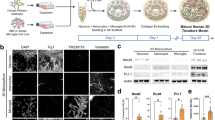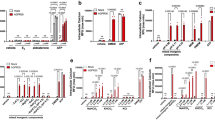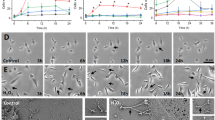Abstract
Gap junctions are conductive channels that connect the interiors of coupled cells. We determined whether gap junctions propagate transcellular signals during metabolic stress and whether such signaling exacerbates cell injury. Although overexpression of the human proto-oncogene bcl2 in C6 glioma cells normally increased their resistance to injury, the relative resistance of bcl2+ cells to calcium overload, oxidative stress and metabolic inhibition was compromised when they formed gap junctions with more vulnerable cells. The likelihood of death was in direct proportion to the number and density of gap junctions with their less resistant neighbors. Thus, dying glia killed neighboring cells that would otherwise have escaped injury. This process of glial 'fratricide' may provide a basis for the secondary propagation of brain injury in cerebral ischemia.
This is a preview of subscription content, access via your institution
Access options
Subscribe to this journal
Receive 12 print issues and online access
$209.00 per year
only $17.42 per issue
Buy this article
- Purchase on Springer Link
- Instant access to full article PDF
Prices may be subject to local taxes which are calculated during checkout






Similar content being viewed by others
References
Ginsberg, M. Neuroprotection in brain ischemia: an update. The Neuroscientist 1, 95–103 (1995).
Siesjo, B. et al. Glutamate, calcium, and free radicals as mediators of ischemic brain damage. Ann. Thorac. Surg. 59, 1316–1320 (1995).
Hossmann, K. Viability thresholds and the penumbra of focal ischemia. Ann. Neurol. 36, 557–565 (1994).
Nedergaard, M. in Cellular and Molecular Mechanisms of Ischemic Brain Damage (eds Siesjo, B. K. & Wieloch, T.) 301–331 (Lippincott-Raven, Philadelphia, 1996).
Hoehn-Berlage, M. et al. Evolution of regional changes in apparent diffusion coefficient during focal ischemia of rat brain. J. Cereb. Blood Flow Metab. 15, 1002–1011 (1995).
Goldberg, M. & Choi, D. Combined oxygen and glucose deprivation in cortical cell culture: calcium-dependent and calcium-independent mechanisms of neuronal injury. J. Neurosci. 13, 3510–3524 (1993).
Graham, D. in Greenfield's Neuropathology (eds Adams, J. H. & Duchen, L. W.) 153–268 (Oxford Univ. Press, New York, 1992).
Dermietzel, R. & Spray, D. From neuro-glue ('nervenkitt') to glia: a prologue. Glia 24, 1– 7 (1998).
Kumar, N. & Gilula, N. The gap junction communication channel . Cell 84, 381–388 (1996).
Nadarajah, B., Thomaidou, D., Evans, W. & Parnavelas, J. Gap junctions in the adult cerebral cortex: regional differences in their distribution and cellular expression of connexins. J. Comp. Neurol. 376, 326–342 (1996).
Rohlmann, A. & Wolff, J. R. in Gap Junctions in the Nervous System (eds Spray, D. C. & Dermietzel, R.) 175 –192 (R. J. Landes, Austin, Texas, 1996).
Cotrina, M. et al. Astrocytic gap junctions remain open during ischemic conditions . J. Neurosci. 18, 2520– 2537 (1998).
Warner, D., Ludwig, P., Pearlstein, R. & Brinkhous, A. Halothane reduces focal ischemic injury in the rat when brain temperature is controlled. Anesthesiology 82, 1237–1245 (1995).
Rawanduzy, A., Hansen, A., Hansen, T. W. & Nedergaard, M. Effective reduction of infarct volume by gap junction blockade in a rodent model of stroke. J. Neurosurg. 87, 916–920 (1997).
Saito, R. et al. Reduction of infarct volume by halothane: effect on cerebral blood flow or perifocal spreading depression-like depolarizations. J. Cereb. Blood Flow Metab. 17, 857– 864 (1997).
Hockenbery, D., Nunez, G., Milliman, C., Schreiber, R. & Korsmeyer, S. Bcl-2 is an inner mitochondrial membrane protein that blocks programmed cell death. Nature 348, 334–336 (1990).
Vaux, D., Cory, S. & Adams, J. Bcl2 gene promotes haemopoietic cell survival and cooperates with c-myc to immortalize pre-B cells. Nature 335, 440–443 (1988).
Mirabelli, F. et al. Alterations of surface morphology caused by the metabolism of menadione in mammalian cells are associated with the oxidation of critical sulfhydryl groups in cytoskeletal proteins. Biochem. Pharmacol. 37, 3423–3427 (1988).
Zhong, L.-T. et al. Bcl2 inhibits death of central neural cells induced by multiple agents. Proc. Natl Acad. Sci. USA 90, 4533–4537 (1993).
Zhu, D., Caveney, S., Kidder, G. & Naus, C. Transfection of C6 glioma cells with connexin 43 cDNA: analysis of expression, intercellular coupling, and cell proliferation. Proc. Natl Acad. Sci. USA 88, 1883–1887 (1991).
Sullivan, R. & Lo, C. Expression of a connexin 43/b-galactosidase fusion protein inhibits gap junctional communication in 3T3 cells. J. Cell Biol. 130, 419–429 (1995).
Venance, L., Stella, N., Glowinski, J. & Giaume, C. Mechanism involved in initiation and propagation of receptor-induced intercellular calcium signaling in cultured rat astrocytes. J. Neurosci. 17, 1981–1992 (1997).
Martin, S. et al. Early redistribution of plasma membrane phosphatidylserine is a general feature of apoptosis regardless of the initiating stimulus: inhibition by overexpression of bcl-2 and abl. J. Exp. Med. 182, 1545–1556 (1995).
Saez, J. C., Connor, J. A., Spray, D. C. & Bennett, M. V. L. Hepatocyte gap junctions are permeable to the second messenger, inositol 1,4,5-triphosphate, and to calcium ions. Proc. Natl Acad. Sci. USA 86, 2708–2712 (1989).
Choi, D. Calcium: still center-stage in hypoxic-ischemic neuronal death. Trends Neurosci. 18, 58–60 (1995).
Lam, M. et al. Evidence that bcl-2 represses apoptosis by regulating endoplasmic reticulum-associated Ca2+ fluxes. Proc. Natl Acad. Sci. USA 91, 6569–6573 (1994).
Prehn, J. et al. Regulation of neuronal bcl2 protein expression and calcium homeostasis by transforming growth factor type beta confers wide-ranging protection on rat hippocampal neurons. Proc. Natl Acad. Sci. USA 91, 12599–12603 (1994).
Reed, J. Double identity for proteins of the bcl-2 family. Nature 387, 773–776 (1997).
Wade, M. H., Trosko, J. & Schindler, M. Fluorescence photobleaching assay of gap junction-mediated communication between human cells. Science 232 , 525–5 28 (1986).
Mesnil, M., Piccoli, C., Tiraby, G., Willecke, K. & Yamasaki, H. Bystander killing of cancer cells by herpes simplex virus thymidine kinase gene is mediated by connexins. Proc. Natl Acad. Sci. USA 93, 1831–1835 (1996).
Elfgang, C. et al. Specific permeability and selective formation of gap junction channels in connexin transfected HeLa cells. J. Cell Biol. 129, 805–817 (1995).
Goldberg, S., Bechberger, J. & Naus, C. A pre-loading method of evaluating gap junctional communication by fluorescent dye transfer. Biotechnology 18 , 490–497 (1995).
Dermietzel, R. et al. Differential expression of three gap junction proteins in developing and mature brain tissue. Proc. Natl Acad. Sci. USA 86, 10148–10152 (1989).
Haugland, R.P. in Handbook of Fluorescent Probes and Research Chemicals (ed Spence, M. ) (Portland, Oregon, 1996).
Nedergaard, M., Goldman, S., Desai, S. & Pulsinelli, W. Acid-induced death in neurons and glia. J. Neurosci. 11, 2489–2497 (1991).
Nedergaard, M. Direct signaling from astrocytes to neurons in cultures of mammalian brain cells. Science 263, 1768– 1771 (1994).
Acknowledgements
We thank V. A. Fried for discussions and L. He for technical support. Supported by NIH/NINDS (RO130007 and RO135011). M. N. is an Established Investigator sponsored by the American Heart Association.
Author information
Authors and Affiliations
Corresponding author
Rights and permissions
About this article
Cite this article
Lin, JC., Weigel, H., Cotrina, M. et al. Gap-junction-mediated propagation and amplification of cell injury. Nat Neurosci 1, 494–500 (1998). https://doi.org/10.1038/2210
Received:
Accepted:
Issue Date:
DOI: https://doi.org/10.1038/2210
This article is cited by
-
Sovateltide (ILR-1620) Improves Motor Function and Reduces Hyperalgesia in a Rat Model of Spinal Cord Injury
Neurocritical Care (2024)
-
Chronic brain damage in HIV-infected individuals under antiretroviral therapy is associated with viral reservoirs, sulfatide release, and compromised cell-to-cell communication
Cellular and Molecular Life Sciences (2023)
-
The Missing Piece? A Case for Microglia’s Prominent Role in the Therapeutic Action of Anesthetics, Ketamine, and Psychedelics
Neurochemical Research (2023)
-
Chronic Stress Impairs the Structure and Function of Astrocyte Networks in an Animal Model of Depression
Neurochemical Research (2023)
-
Connexin 43: insights into candidate pathological mechanisms of depression and its implications in antidepressant therapy
Acta Pharmacologica Sinica (2022)



